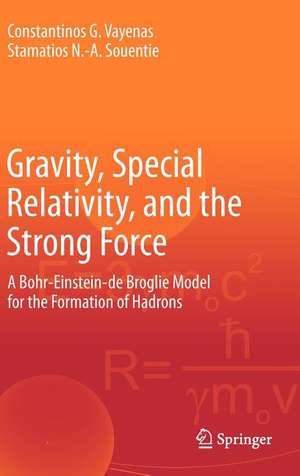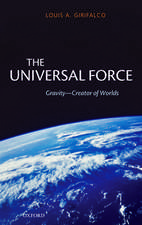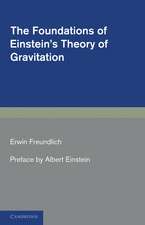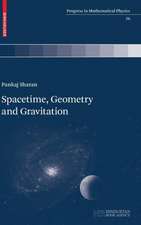Gravity, Special Relativity, and the Strong Force: A Bohr-Einstein-de Broglie Model for the Formation of Hadrons
Autor Constantinos G. Vayenas, Stamatios N.-A. Souentieen Limba Engleză Hardback – 25 iul 2012
The results agree with experiments on the masses, binding energies, radii, angular moments and magnetic moments of hadrons. The model provides the means to rationalize all the main experimental features of the strong force. Some of the implications for the unification of forces and the nature of our micro-cosmos and macro-cosmos are also discussed. The creation of mass itself, in other words, of hadrons from particlesas light as neutrinos, can now be modeled in a straightforward manner.
| Toate formatele și edițiile | Preț | Express |
|---|---|---|
| Paperback (1) | 634.00 lei 6-8 săpt. | |
| Springer Us – 23 aug 2016 | 634.00 lei 6-8 săpt. | |
| Hardback (1) | 640.06 lei 6-8 săpt. | |
| Springer Us – 25 iul 2012 | 640.06 lei 6-8 săpt. |
Preț: 640.06 lei
Preț vechi: 753.01 lei
-15% Nou
Puncte Express: 960
Preț estimativ în valută:
122.49€ • 127.15$ • 102.14£
122.49€ • 127.15$ • 102.14£
Carte tipărită la comandă
Livrare economică 22 martie-05 aprilie
Preluare comenzi: 021 569.72.76
Specificații
ISBN-13: 9781461439356
ISBN-10: 1461439353
Pagini: 164
Ilustrații: XVIII, 144 p.
Dimensiuni: 155 x 235 x 13 mm
Greutate: 0.41 kg
Ediția:2012
Editura: Springer Us
Colecția Springer
Locul publicării:New York, NY, United States
ISBN-10: 1461439353
Pagini: 164
Ilustrații: XVIII, 144 p.
Dimensiuni: 155 x 235 x 13 mm
Greutate: 0.41 kg
Ediția:2012
Editura: Springer Us
Colecția Springer
Locul publicării:New York, NY, United States
Public țintă
ResearchCuprins
1905-1930: The golden age of physics.- Mass, special relativity and the equivalence principle.- The strong force: From quarks to hadrons and nuclei.- The world of particles and the standard model.- The equivalence principle, special relativity and Newton's gravitational law.- The three and two rotating neutrino models: Particle confinement by gravity.- Energy and other properties of the rotational states.- Gravitational hadronization: How mass can be produced from gravity.- Model comparison with the main experimental features of the strong interaction force.- The Bohr-de Broglie approach in physics: The dual nature of matter.- Gravity at relativistic velocities and dark matter.- Force unification: Is the strong force simply gravity?.
Textul de pe ultima copertă
This book shows that the strong interaction forces, which keep hadrons and nuclei together, are relativistic gravitational forces exerted between very small particles in the mass range of neutrinos. First, this book considers the motion of two or three charged particles under the influence of electrostatic and gravitational forces only, which shows that bound states are formed by following the same semi-classical methodology used by Bohr to describe the H atom. This approach is also coupled with Newton’s gravitational law and with Einstein’s special relativity.
The results agree with experiments on the masses, binding energies, radii, angular momenta and magnetic moments of hadrons. The model provides the means to rationalize all the main experimental features of the strong force. Some of the implications for the unification of forces and the nature of our micro-cosmos and macro-cosmos are also discussed. The creation of mass itself, in other words, of hadrons from particlesas light as neutrinos, can now be modeled in a straightforward manner.
The results agree with experiments on the masses, binding energies, radii, angular momenta and magnetic moments of hadrons. The model provides the means to rationalize all the main experimental features of the strong force. Some of the implications for the unification of forces and the nature of our micro-cosmos and macro-cosmos are also discussed. The creation of mass itself, in other words, of hadrons from particlesas light as neutrinos, can now be modeled in a straightforward manner.
Caracteristici
First book to present the Bohr-Einstein-de Broglie approach to the formation of hadrons and nuclei Demonstrates that strong forces are relativistic graviational forces Explains confinement and asymptotic freedom















